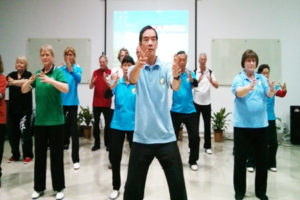
By John M. de Castro, Ph.D.
“mindfulness exercises delivered in face-to-face settings or remotely via the Internet seem to yield similar changes in symptoms. The remote delivery does not seem to lessen the efficacy of mindfulness interventions.”– Johanna Boettcher
Mindfulness training has been shown through extensive research to be effective in improving the physical and psychological condition of otherwise healthy people and also treating the physical and psychological issues of people with illnesses. Techniques such as Mindfulness-Based Stress Reduction (MBSR) and Mindfulness-Based Cognitive Therapy (MBCT) as well as Yoga practice and Tai Chi or Qigong practice have been demonstrated to be particularly effective. This has led to an increasing adoption of these mindfulness techniques for the health and well-being of both healthy and ill individuals.
The vast majority of the mindfulness training techniques, adopted so far, require a certified trained therapist. This produces costs that many clients can’t afford. In addition, the participants must be available to attend multiple sessions at particular scheduled times that may or may not be compatible with their busy schedules. As a results, there has been attempts to develop on-line mindfulness training programs. These have tremendous advantages in decreasing costs and making training schedules much more flexible. But, the question arises as to whether these programs are as effective as their traditional counterparts. Many believe that the presence of a therapist is a crucial component to the success of the programs and the lack of an active therapist in on-line programs may greatly reduce their effectiveness.
In today’s Research News article “Mindfulness Interventions Delivered by Technology Without Facilitator Involvement: What Research Exists and What Are the Clinical Outcomes?” See:
or see summary below or view the full text of the study at:
http://www.ncbi.nlm.nih.gov/pmc/articles/PMC5010616/
Fish and colleagues review the published research literature on the effectiveness of technology-based mindfulness training programs that did not include an active facilitator’s participation. They found 10 studies published, 9 of which were web-based programs. They found that, in general, the mindfulness programs produced increases in mindfulness and reductions in perceived stress, depression, anxiety, and rumination and these effects were maintained at follow-ups occurring as much as 6-months later. Unfortunately, compliance was relatively low and drop-out rates were relatively high.
These are encouraging findings and suggest that mindfulness can be effectively trained with web-based materials and that this can produce psychologically beneficial results. But, there were no direct comparisons to traditional programs. So, it cannot be determined if the web-based programs are as effective as traditional programs. In addition, there methods need to be developed to help maintain compliance and decrease dropping out of web-based programs. Regardless, the benefits are substantial and the results are sufficiently positive to encourage further research.
So, get mindful on-line and get feeling better.
“Internet delivery of mindfulness training may be a viable alternative if an evidence base can be established. It can be self-paced, less costly, and more accessible while additionally allowing for participant anonymity. “ – David Messer
CMCS – Center for Mindfulness and Contemplative Studies
This and other Contemplative Studies posts are also available on Google+ https://plus.google.com/106784388191201299496/posts
Study Summary
Fish, J., Brimson, J., & Lynch, S. (2016). Mindfulness Interventions Delivered by Technology Without Facilitator Involvement: What Research Exists and What Are the Clinical Outcomes? Mindfulness, 7(5), 1011–1023. http://doi.org/10.1007/s12671-016-0548-2
Abstract
New cost-effective psychological interventions are needed to contribute to treatment options for psychiatric and physical health conditions. This systematic review aims to investigate the current literature on one potentially cost-effective form of mindfulness-based therapy, those delivered through technological platforms without any mindfulness facilitator input beyond the initial design of the programme. Three electronic databases (Ovid Medline, PsychINFO and Embase) were searched for relevant keywords, titles, medical subject headings (MeSH) and abstracts using search terms derived from a combination of two subjects: ‘mindfulness’ and ‘technology’. Overall, ten studies were identified. The majority of studies were web-based and similar in structure and content to face-to-face mindfulness-based stress reduction courses. Clinical outcomes of stress (n = 5), depression (n = 6) and anxiety (n = 4) were reported along with mindfulness (n = 4), the supposed mediator of effects. All eight studies that measured significance found at least some significant effects (p < .05). The highest reported effect sizes were large (stress d = 1.57, depression d = .95, both ps > .005). However, methodological issues (e.g. selection bias, lack of control group and follow-up) which reflect the early nature of the work mean these largest effects are likely to be representative of maximal rather than average effects. Whilst there are important differences in the construction, length and delivery of interventions, it is difficult to draw firm conclusions about the most effective models. Suggestions of key characteristics are made though, needing further investigation preferably in standardised interventions. Given the existing research and the speed at which technology is making new platforms and tools available, it seems important that further research explores two parallel lines: first, refinement and thorough evaluation of already established technology-based mindfulness programmes and second, exploration of novel approaches to mindfulness training that combine the latest technological advances with the knowledge and skills of experienced meditation teachers.
http://www.ncbi.nlm.nih.gov/pmc/articles/PMC5010616/








